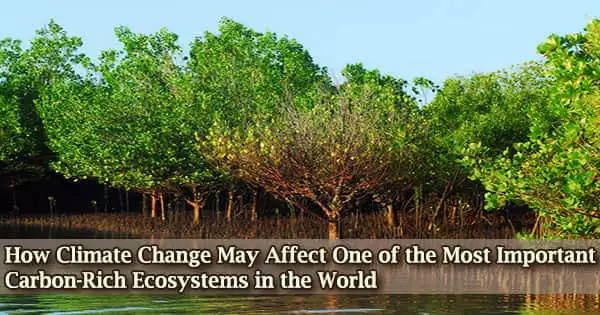The health of our world is greatly influenced by mangrove forests. The trees and shrubs serve as nurseries for young fish, absorb a significant amount of greenhouse gas emissions, and safeguard towns from increasing sea levels.
With the capacity to store more than 1,000 tons of carbon in only one hectare, or about the size of a football field, these coastal forests are the second most carbon-rich environment in the entire planet. In order to accomplish this, they take the chemical element from the air and store it in their leaves, branches, trunks, and roots.
However, despite environmental efforts to save these significant ecosystems, they are still in danger. Mangroves have larger below-to-above-ground carbon mass ratios than terrestrial trees and distribute a greater proportion of their carbon below the surface.
A recent study headed by the University of Portsmouth and supported by the research group Operation Wallacea has shown how organisms process the carbon from atmospheric CO2 that is deposited in massive woody waste. The results indicate climate change may greatly impact that this “blue carbon” system.
Mangroves have the highest carbon density of any terrestrial ecosystem, according to scientific studies, and they sequester carbon 2-4 times more than mature tropical forests. A mature mangrove forest can absorb 840 metric tonnes of carbon dioxide per hectare with an average tree growth span of 25 years.
This indicates that over the course of a mangrove tree’s growth, or 12.3 kilogram each year, it will remove 308 kg (0.3 tonnes) of CO2 from the atmosphere. Large pools of soil carbon and dead roots hold the majority of mangrove carbon.
With an average carbon content of 937 tC ha-1, mangroves are one of the most carbon-rich biomes. They also promote rapid rates of sediment accretion (∼5 mm year -1) and carbon burial (174 gC m-2 year -1). Mangroves only contribute about 1% (13.5 Gt year -1) of the carbon that the world’s forests store, but since they are coastal habitats, they contribute 14 percent of the carbon that the world’s oceans store.
This data highlights the delicate balance between wood-biodegrading organisms and fallen mangrove wood. Mangrove forests are crucial to mitigating climate change, and alterations to the breakdown of fallen wood in the forests will change the above-ground carbon cycles which may have an effect on mangrove carbon stores.
Dr. Ian Hendy
Researchers from the University of Portsmouth examined large woody debris (LWD) in four mangrove forests with various intertidal zones in Indonesia’s Wakatobi National Park. There were up to 8 parts (transects) per survey region, each of which revealed a different method of carbon processing.
The scientists identified species generally found in tropical rainforests are breaking down fallen wood in the higher regions of the ecosystem, closer to shore. These consist of termites, fungus, and beetle larvae. The LWD is being deteriorated more quickly closer to the ocean by shipworms, which are worm-like clams with calcium carbonate shells.
Two effects of climate change have the potential to impede the delicate process of mangrove forest fixed-carbon degradation. The carbon cycle is governed by tidal elevation, hence the first effect is an increase in sea levels.
The second is an increase in ocean acidity brought on by rising atmospheric CO2, which can dissolve marine animals’ shells, deteriorating wood in lower reaches. Lead author of the study, Dr. Ian Hendy from the University of Portsmouth’s School of Biological Sciences, said:
“This data highlights the delicate balance between wood-biodegrading organisms and fallen mangrove wood. Mangrove forests are crucial to mitigating climate change, and alterations to the breakdown of fallen wood in the forests will change the above-ground carbon cycles which may have an effect on mangrove carbon stores.”
Now, Dr. Hendy and his group are aiming to participate in Mexico’s extensive mangrove forest rehabilitation.
A team of scientists from Portsmouth, Brighton, Singapore, and CINESTAV are collaborating solely with the joint biodiversity effort rePLANET to fund a number of PhD projects that look at the cutting-edge measures being used to protect and maintain forests.
“The team’s goal now is to use the findings from this study to guide large-scale restoration of mangrove forests across the globe,” added the study’s co-author, Dr. Simon Cragg from the University of Portsmouth.





